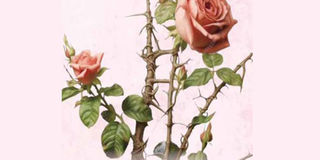
Paul Kasobya’s poetry collection employs the image and idea of the rose to express the pains and gains of life. Roses symbolise love, delicacy, beauty and destiny. They are also associated with celebration and perfection. Their fragrances are as distinct as their varieties.
This makes them ideal in expressing the varied facets of life.
The thorns on a rose, alternately, convey the grittier yet redemptive side of life. Although denoting suffering, the thorn is an emblem of Christ’s passion, as with the crown of thorns. And thus symbolises deliverance, too.
Again, the thorns on the rose are often found at the nodes on a stem where you would find leaves and branches emerging.
“Emerging” is the operative word as it represents a life materializing.
“You walk on a balance, on a precarious path; to the left is the vastness of nothingness that follows us after we die, to the right is the garden of life, the garden of roses and thorns,” Kasobya writes.
It is through these emergent contrasts that we experience life in the round.
In the poem “Let Me Love You”, the author is not evoking Mario’s 2004 R&B ballad of the same name. Instead, he is expressing a dimension of life as told by his own passions.
“Let me love you
From my heart’s chest,
From the flower’s waist,
From where my mind eats,
From the star’s wick.
Less of wealth is my own---
I love you not from my wallet,
Not with shopping malls,
Where gold and vanity are sold.”
He simplifies and clarifies his love not only by the repetitions at the beginning of the last four lines in the first stanza (known as Anaphora—repeat a word or phrase at the beginning of successive phrases, clauses, or sentences).
But by the fact that his love has no strings or conditionalities attached to it. It is young, free and a little naïve. Therein dwells its rose-like quality: its delicacy, beauty and purity.
Of course, a love found would be nothing without a love lost.
“You taught me endurance,
Proving the possibility of life
Without you.
You gave me reasons to give up
When you hid your face
In the pile of hours and days
Of silence.”
Light and shade, the love and the lovelorn, these are the contrasts that keep us humble in our passions.
For one minute you are alive to a love that seems to have no end. And the next, tears stain the love letter containing the undying words: it is over.
It is this polarity that gives life its diversity. It is also this contrariety that makes love so forbidding to most.
But still, as expressed in the last stanza of this poem, it is what redeems love itself.
“These eyes no longer cry,
This heart breaks no more
The feeling of love is loveless the more
For you.”
You see, just as you thought that the persona had given up on love. Just as you thought that he was just another tragedian with a sob story as old feeling; the last line changes everything.
Love does not have to end in the shadow of its own death, but can shine forth anew with another person.
As the saying goes, to get over a broken heart one must find a new one.
This lost love is a microcosm of life where loss and gain are part of every life story there ever was.
The author puts it well in his preface:
“Roses in thorns, a statement that is as true as it is inspiring of an imagination of beauty placed within risk, is indeed a befitting nomenclature for a collection of verses that describe the intricacy and convolutions of life that is evidently thus.”
He goes on, “I would want to pick the rose, we all shall say, but the glaring thorns that dare prick us already as they threaten our advancement into the ventures of life pose too great a retardation of our spiritual zeal, and all elements alike, love, for instance, or power or the human will.”
Possibly, in tribute to the better angels of your nature, you may risk the thorns in order to smell the roses.
Author: Paul Kasobya
Title: Roses in Thorns: The Mirths and Wraths of Life
Price: Shs 30,000
Published: 2024
Pages: 98
Availability: Uganda Museum Library




